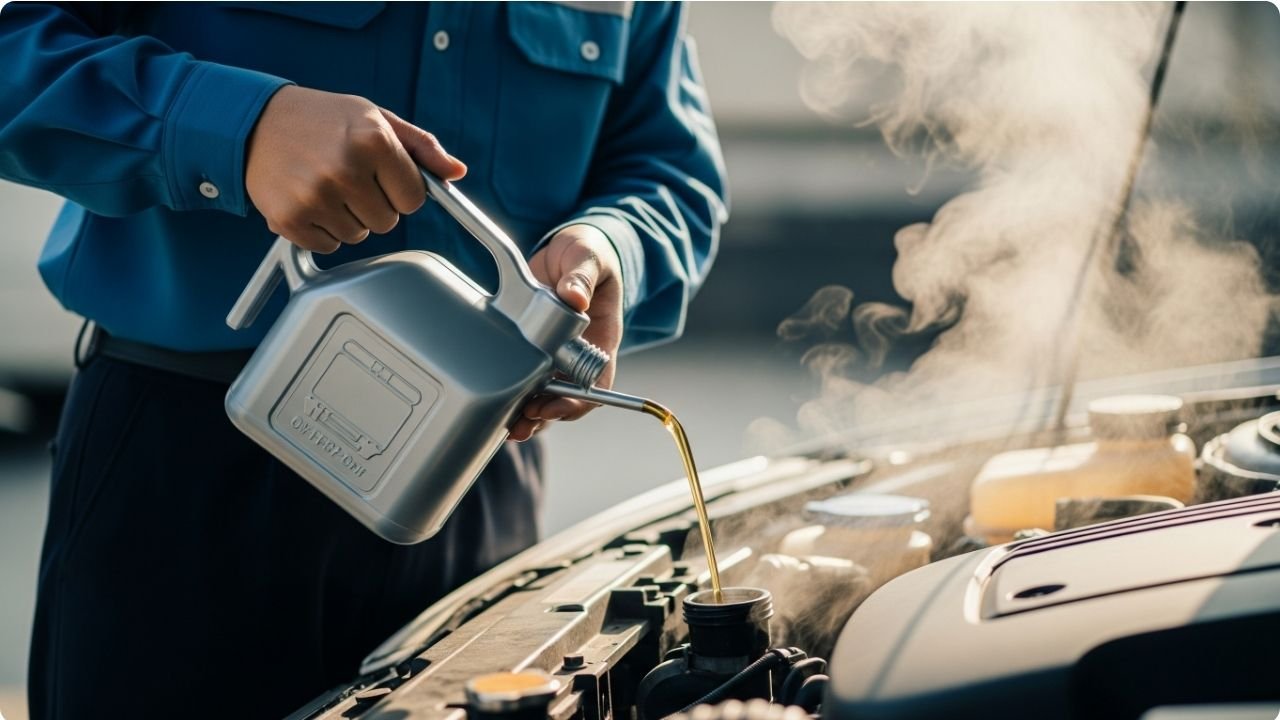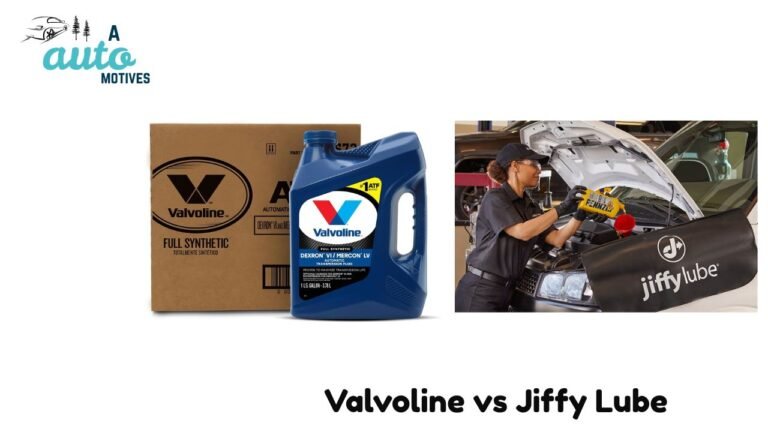Can You Add Oil to Car When It’s Hot?

We’ve all been there.
You’re parked at a gas station or outside your home. Maybe you just finished a long drive. You pop the hood, check the dipstick, and—oh no—it’s low on oil.
Then the worry kicks in. Can you add oil to car when it’s hot? Should you wait for it to cool down? Or is this going to lead to something dramatic like a cracked engine block or an oil fire?
Take a deep breath. Let’s walk through this together like two friends leaning on a car hood on a Sunday afternoon. I’ll share the facts, some personal stories, and what mechanics really mean when they warn you about “hot oil.”
Let’s start with the basics.
In This Article
- 1 Understanding How Oil Works in a Car (Without Getting Too Technical)
- 2 Real Talk: What Happens If You Add Oil to a Hot Engine?
- 3 How Long Should You Wait After Driving Before Adding Oil?
- 4 Signs You Need to Add Oil ASAP (Even If the Car Is Hot)
- 5 Adding Oil to a Hot vs Cold Engine
- 6 Common Mistakes When Adding Oil to a Hot Engine
- 7 Quick Tips to Safely Add Oil to a Warm Engine
- 8 Why This Question Matters More Than You Think
- 9 Myths About Hot Engines and Oil – Let’s Bust Them
- 10 When You Should Absolutely Wait
- 11 Adding Oil the Right Way: A Step-by-Step Guide
- 12 Relatable Truth: Oil Isn’t Just for Mechanics—It’s for Everyone
- 13 Why This Question Is Even More Important in Hot Climates
- 14 FAQs About Adding Oil to a Hot Car
- 14.1 1. Can you add oil to car when it’s hot without causing damage?
- 14.2 2. Is it better to add oil when the engine is hot or cold?
- 14.3 3. What happens if I overfill my engine oil?
- 14.4 4. Can I drive immediately after adding oil to a hot engine?
- 14.5 5. Will adding cold oil to a hot engine damage it?
- 14.6 6. Should I use different oil in hot weather?
- 14.7 7. What if my oil light comes on after driving?
- 15 Final Thoughts: Don’t Fear the Oil—Respect It
Understanding How Oil Works in a Car (Without Getting Too Technical)

But when the car is turned off, the oil doesn’t instantly cool. It stays hot—sometimes scalding hot—for a while.
So here’s what you need to know:
-
Hot engines don’t mean disaster. Most car manuals assume you’ll be checking and adding oil when the engine is warm.
-
Cold engines give clearer readings. Mechanics often prefer checking oil when the engine is cold or has rested for 10–15 minutes.
-
Adding oil when hot isn’t dangerous—if you’re careful.
So, the short answer? Yes, you can add oil to a car when it’s hot, but you’ve got to know what you’re doing.
Real Talk: What Happens If You Add Oil to a Hot Engine?
Here’s where experience kicks in.
Last year, I drove from Chittagong to Sylhet—about a six-hour journey. When I pulled over and checked the oil, it was below the minimum mark. I had a liter of 10W-30 in the trunk. I hesitated. Should I pour it in now or wait?
Here’s what happens when you add oil to a hot engine:
-
If the engine is running, never add oil. You could splash hot oil or hit moving parts.
-
If the engine is off but still warm, adding oil is generally safe.
-
If the oil filler cap is hot, use a cloth to open it. Don’t risk burns.
-
The new oil will mix with the hot oil instantly, and that’s fine—it’s made to handle heat.
Modern oils are designed to withstand high temperatures. But don’t pour it all in like you’re filling a jug of water. Go slow. Let it settle. Check the dipstick again after a minute or two.
How Long Should You Wait After Driving Before Adding Oil?
Now that’s a great question.
If you want to be safe and precise, wait 15 to 20 minutes after shutting off your engine. This gives the oil time to:
-
Drain down to the oil pan (so you get an accurate reading)
-
Cool just enough to avoid burns or steam
-
Settle evenly so you don’t overfill
But let’s be real. Sometimes, you’re in a hurry. Maybe you’re on the side of a highway or in scorching summer heat. If that’s the case, and you can’t wait, just be cautious and follow this golden rule:
“Slow is smooth. Smooth is safe.”
Use a funnel. Pour slowly. Wait a moment. Repeat.
Signs You Need to Add Oil ASAP (Even If the Car Is Hot)
You might not always have the luxury of time. There are some moments where waiting isn’t an option—you must add oil, hot engine or not.
Here are those red-flag moments:
-
Oil warning light is on
-
Dipstick shows below minimum
-
Ticking or knocking noise from the engine
-
Burning smell from the hood
-
Overheating warning on the dashboard
If any of these happen, especially on a long drive, add oil right away—carefully. Your engine needs that lubrication immediately.
Adding Oil to a Hot vs Cold Engine
| Situation | Is It Safe to Add Oil? | Precautions to Take |
|---|---|---|
| Engine still running | No | Never add oil while the engine is running |
| Just turned off | Yes, with care | Use a cloth to handle parts; pour slowly |
| Waited 15–20 minutes | Best time | Most accurate reading and safest temperature |
| Cold overnight | Very safe | Best for precise dipstick reading |
This table gives you a visual cheat sheet the next time you’re on the fence about oil and engine temperature.
Common Mistakes When Adding Oil to a Hot Engine
Even with good intentions, it’s easy to mess this up. Trust me—I’ve done it. Once, I added oil too quickly, overfilled it, and ended up with smoke from the tailpipe and a trip to the mechanic.
Here’s what to avoid:
-
Overfilling the oil. This causes pressure build-up, leaks, or foaming.
-
Using the wrong oil type. Always check your car’s manual.
-
Pouring too fast. This can cause spills or overflow.
-
Not checking the dipstick after topping off.
-
Forgetting the cap. Seems silly, but you’d be surprised how many people do this.
Want a metaphor? Think of it like making tea. You wouldn’t dump boiling water onto delicate tea leaves all at once—you’d pour gently, letting the flavor settle in. Same with oil and your engine.
Quick Tips to Safely Add Oil to a Warm Engine
Let’s boil it down. Here are the do’s and don’ts:
Do:
-
Let the car rest for 10–15 minutes
-
Use a funnel to avoid spills
-
Pour slowly in small amounts
-
Use the correct grade of oil
-
Check the dipstick after adding
Don’t:
-
Add oil while the engine is running
-
Overfill past the max line
-
Use oil not meant for your engine
-
Forget to close the oil cap tightly
Adding oil isn’t rocket science—but it does need attention. Think of it like feeding your pet. You wouldn’t just toss food without checking if it’s the right kind or the right amount, right?
Why This Question Matters More Than You Think
At first glance, “can you add oil to car when it’s hot?” sounds like a basic yes-or-no. But behind that question is a bigger truth: your engine is a living, breathing part of your car’s soul. And how you treat it affects how long it lasts, how smoothly it runs, and whether you’ll spend your next weekend driving or at the repair shop.
I’ve seen both sides. I’ve ignored oil levels and paid the price. I’ve also treated oil like gold, and my car has thanked me with 300,000+ kilometers of faithful service.
Your car is listening. And when it’s hot and asking for oil, it’s not trying to confuse you. It just needs a little care—and a bit of patience.
Myths About Hot Engines and Oil – Let’s Bust Them
Let’s clear the fog. Car care advice often feels like it was passed down from someone’s grandfather in the 1950s. While some of it holds up, a lot of it doesn’t.
Here are common myths around this topic—and the actual truth:
Myth 1: “Adding oil to a hot engine will crack the engine block.”
Nope. Not true.
Engines are designed to handle temperature swings. You’d have to pour ice-cold water—not oil—for that kind of damage. Engine oil is heat-resistant by design. Pouring oil into a hot engine won’t harm it—unless you overfill or use the wrong type.
Myth 2: “You must always wait until the engine is stone cold.”
Not necessary.
Yes, waiting gives you a clearer oil level reading, but it’s safe to add oil when the engine is warm—as long as it’s turned off and you’re careful.
Myth 3: “Synthetic oils behave differently in hot engines.”
Yes, but not in a dangerous way.
Synthetic oils are actually more stable in high temperatures. If anything, they’re safer to add than old-school conventional oils.
Truth:
-
Oil blends with warm engine oil naturally.
-
Your engine is built to run hot. It’s not fragile.
-
Just pour slowly, and don’t rush the process.
When You Should Absolutely Wait
While adding oil to a warm engine is mostly fine, there are a few cases when patience pays off:
-
You’re unsure of the dipstick reading. Oil expands when hot. A cold engine gives a more accurate level.
-
You’re topping off after a full oil change. Always wait and check after 10–15 minutes.
-
You’re driving in extreme climates like desert heat or freezing winter. Oil behavior changes a bit with temperature extremes.
A good friend of mine in Dhaka once poured a full liter into a hot engine after a 40°C drive without checking the level first. The result? An overfill, white smoke, and a ride to the garage.
Sometimes, waiting a few extra minutes can save hours of hassle.
Adding Oil the Right Way: A Step-by-Step Guide
Let’s get hands-on. Here’s a simple process you can follow any time you need to add oil—hot or not:
Step 1: Park and Turn Off the Engine
Always start here. Never add oil with the engine running.
Step 2: Let It Rest for 10–20 Minutes
This helps oil drain into the pan and reduces heat around the oil cap.
Step 3: Pop the Hood and Find the Oil Cap
Use a rag if it’s hot to touch. Look for the oil filler cap, not the dipstick.
Step 4: Check the Dipstick
Wipe it, dip it back in, then pull it out again. Look for “min” and “max” marks.
Step 5: Add Small Amounts Slowly
Use a funnel and pour about 100–200 ml at a time. Wait a bit, then check again.
Step 6: Don’t Overfill
Stay just below or at the “max” mark. Overfilling can cause damage.
Step 7: Replace the Cap Tightly
Close everything securely before driving again.
Relatable Truth: Oil Isn’t Just for Mechanics—It’s for Everyone
We often think car maintenance is a guy thing. Or a mechanic thing. But here’s the truth: knowing when and how to add oil to a car when it’s hot is part of modern adulting.
Whether you’re a university student driving an old Corolla or a working mom handling the family SUV—this knowledge empowers you. It’s not about being a car expert. It’s about taking care of what carries you through life.
When I learned how to check and add oil myself, I felt a surprising sense of control. Like I was speaking the car’s language for the first time. And honestly? It felt good.
Why This Question Is Even More Important in Hot Climates
Living in Bangladesh, the summers are brutal. Your engine stays hot even 30–40 minutes after a drive. So, the question “can you add oil to car when it’s hot” becomes more practical than hypothetical.
If you’re in places like:
-
Dhaka
-
Khulna
-
Rajshahi
-
Barisal
You’re probably dealing with elevated engine temperatures regularly. That means:
-
Check oil levels more often
-
Use synthetic or high-temperature-rated oils
-
Be cautious, but not scared of topping off while warm
Sometimes, doing the right thing for your car means trusting your instincts, observing carefully, and not panicking.
FAQs About Adding Oil to a Hot Car
1. Can you add oil to car when it’s hot without causing damage?
Yes, you can. Just make sure the engine is turned off and you pour the oil slowly. Avoid adding oil to a running or extremely hot engine.
2. Is it better to add oil when the engine is hot or cold?
It’s easier and more accurate to check and add oil when the engine is slightly warm or has been off for 10–15 minutes. Cold readings are more precise, but warm additions are safe.
3. What happens if I overfill my engine oil?
Overfilling can cause foaming, oil leaks, engine misfires, and even damage to internal parts. Always add small amounts and check levels as you go.
4. Can I drive immediately after adding oil to a hot engine?
Yes. As long as the oil level is correct and everything is secured, you can safely drive off after adding oil.
5. Will adding cold oil to a hot engine damage it?
Not at all. Engine oil is formulated to handle temperature shifts. Just pour slowly to avoid sudden steam or splash-back.
6. Should I use different oil in hot weather?
Yes. Thicker oils or synthetic blends rated for high heat may perform better in hot climates. Always refer to your vehicle’s manual.
7. What if my oil light comes on after driving?
Stop the car safely, wait a few minutes, then check the oil level. Add oil if needed. If the light stays on, consult a mechanic.
Final Thoughts: Don’t Fear the Oil—Respect It
To wrap things up, here’s the big takeaway:
Yes, you can add oil to your car when it’s hot. Just be cautious, use small amounts, and never pour with the engine running. Like making a good cup of tea, it’s all about timing and care.
Your engine will love you for it. And you’ll avoid breakdowns, costly repairs, and those heart-sinking dashboard lights.
Keep a small bottle of your preferred oil in your trunk. Carry a funnel. Trust your gut. And don’t let fear stop you from taking action when your car asks for a little love.
Remember: oil isn’t just a fluid—it’s a lifeline.






